- Bean Threads
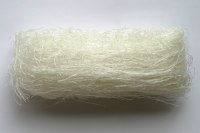 Thin noodles made from mung bean paste, the same beans which you eat as ‘bean sprouts’. These noodles are sometimes called ‘bean threads’, ‘bean noodles’ or ‘cellophane noodles’. They are somewhat translucent. Do not confuse them with the similar shaped thin rice noodles which are white and made from rice.
Thin noodles made from mung bean paste, the same beans which you eat as ‘bean sprouts’. These noodles are sometimes called ‘bean threads’, ‘bean noodles’ or ‘cellophane noodles’. They are somewhat translucent. Do not confuse them with the similar shaped thin rice noodles which are white and made from rice.Storage: Store these noodles in an air tight container in the cabinet. They will keep for a long time if kept dry.
- Black Sticky Rice
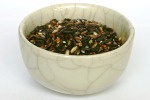 This rice is very sticky and a very dark purplish color when cooked. You must soak the rice for at least 2 hours before steaming it. It’s mainly used in desserts.
This rice is very sticky and a very dark purplish color when cooked. You must soak the rice for at least 2 hours before steaming it. It’s mainly used in desserts. - Fermented Rice Noodles
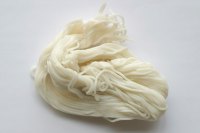 Noodles made from rice. These are commonly (only?) eaten with a type of fish curry.
Noodles made from rice. These are commonly (only?) eaten with a type of fish curry. - Jasmine Rice
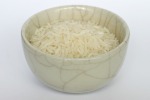 Jasmine rice is the base of almost all Thai dishes. Thai jasmine rice is fragrant, sweet and nutty, and should never be substituted with other types of rice. You can learn how to make the perfect batch of rice here: How to make rice article.
Jasmine rice is the base of almost all Thai dishes. Thai jasmine rice is fragrant, sweet and nutty, and should never be substituted with other types of rice. You can learn how to make the perfect batch of rice here: How to make rice article.Storage: Store uncooked rice in a sealed container. Make sure to check the bag when you buy it that it does not contain rice-eating bugs. Once cooked, rice should be stored in the refrigerator and eaten within 24 hours. It’s very common to get sick off old rice, so if you’re unsure, just make a new batch.
- Ma Ma Instant Ramen Noodles
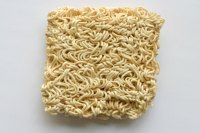 Ma Ma Brand instant ramen noodles are very popular in Thailand. In fact, there’s usually a whole aisle delegated to them at the big supermarkets. Ma Ma brand is the tastiest, and can be found exported outside Thailand at many Asian groceries. They come in a million flavors, and are a lot tastier than the Japanese cheapie ramen I grew up on as a kid.
Ma Ma Brand instant ramen noodles are very popular in Thailand. In fact, there’s usually a whole aisle delegated to them at the big supermarkets. Ma Ma brand is the tastiest, and can be found exported outside Thailand at many Asian groceries. They come in a million flavors, and are a lot tastier than the Japanese cheapie ramen I grew up on as a kid.Storage: Store instant noodles in a dry place. If they get damp the noodles get really yucky.
- Medium Rice Noodles
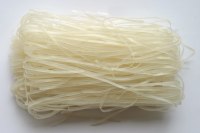 These noodles can usually be found dried, sometimes fresh. Sometimes on the package they are called ‘Sen Lek’ or ‘Pad Thai Noodles’. They have a variety of uses outside of Pad Thai, however. Soak in room-temp water 30 minutes before using to soften.
These noodles can usually be found dried, sometimes fresh. Sometimes on the package they are called ‘Sen Lek’ or ‘Pad Thai Noodles’. They have a variety of uses outside of Pad Thai, however. Soak in room-temp water 30 minutes before using to soften.Storage: Store rice noodles in an air tight container in the cabinet. They will keep for a long time if kept dry.
- Spring Roll Wrappers
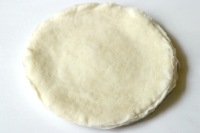 Spring roll wrappers are very thin sheets made from wheat flour. They are similar to Chinese ‘egg roll’ wrappers, but usually sold round. You can usually find these frozen in SE Asian or Chinese markets. Square spring roll wrappers work fine! When using, make sure your wrappers don’t dry out. If they do, they get brittle and break.
Spring roll wrappers are very thin sheets made from wheat flour. They are similar to Chinese ‘egg roll’ wrappers, but usually sold round. You can usually find these frozen in SE Asian or Chinese markets. Square spring roll wrappers work fine! When using, make sure your wrappers don’t dry out. If they do, they get brittle and break.Storage: If buying fresh, you can freeze these in your freezer for long-term storage. If frozen, keep so until ready to use.
- Sticky Rice
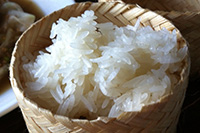 Sticky Rice is eaten primarily in the North & North Eastern parts of Thailand. However, sticky rice with coconut milk and sugar is eaten with mangoes all over the country.
Sticky Rice is eaten primarily in the North & North Eastern parts of Thailand. However, sticky rice with coconut milk and sugar is eaten with mangoes all over the country. - Thin Rice Noodles
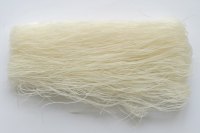 Sometimes these are called “Rice Sticks” or “Sen Mee” in Thai. Do not confuse these with bean threads, which are made from mung bean paste, and not rice. Soak for 10 minutes in room-temperature water before using.
Sometimes these are called “Rice Sticks” or “Sen Mee” in Thai. Do not confuse these with bean threads, which are made from mung bean paste, and not rice. Soak for 10 minutes in room-temperature water before using.Storage: Store rice noodles in an air tight container in the cabinet. They will keep for a long time if kept dry.
- Wheat Noodles
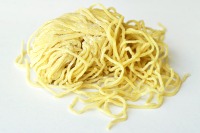 Chinese style wheat noodles. This type of noodles is also known as “egg noodles”. Very popular in noodle soup and eaten boiled ‘dry’ with scallions, etc.
Chinese style wheat noodles. This type of noodles is also known as “egg noodles”. Very popular in noodle soup and eaten boiled ‘dry’ with scallions, etc. - Wide Rice Noodles
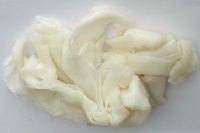 Wide rice noodles are usually found fresh. If you are lucky enough to find them fresh (ie: not refrigerated), do not refrigerate, and use that day. Putting these noodles in the refrigerator makes them hard, and they break apart in the pan a lot easier when fried. You may be able to find them dried or frozen, but fresh is best.
Wide rice noodles are usually found fresh. If you are lucky enough to find them fresh (ie: not refrigerated), do not refrigerate, and use that day. Putting these noodles in the refrigerator makes them hard, and they break apart in the pan a lot easier when fried. You may be able to find them dried or frozen, but fresh is best. - Wonton Wrappers
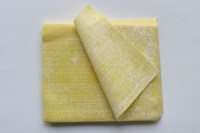 Wonton Wrappers are thin sheet noodles made from wheat. Usually they are stuffed and fried, steamed, or boiled in soup. Sometimes they are fried alone and eaten as a crispy cracker in noodle soup.
Wonton Wrappers are thin sheet noodles made from wheat. Usually they are stuffed and fried, steamed, or boiled in soup. Sometimes they are fried alone and eaten as a crispy cracker in noodle soup.Storage: Store wonton wrappers sealed in the refrigerator, and use within a few days of opening.